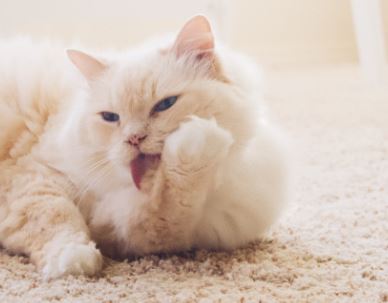
Have you ever gone to pet your cat and discovered that their fur is thinner than usual or that they have bald patches? There are various reasons your cat may be shedding fur, so it’s important to have a vet examine it. The best approach to identify any early symptoms of sickness is through routine vet visits.
Here are a few cat symptoms to be on the lookout for. Keep in mind that this isn’t a complete list, and if you’re concerned about your pet’s health, you should always discuss it with your vet.
Understanding Alopecia in Cats
Alopecia, which simply means baldness, is a term frequently used to describe hair loss in cats. Alopecia in cats can come in various forms. Acquired alopecia is the most prevalent cause of alopecia, and the most common reasons are related to underlying medical conditions.
Alopecia, however, can occasionally develop without any underlying conditions being present. For instance, some cats, like Sphinxes, have genetic alopecia, meaning they are born without hair and never develop any.
Siamese cats often get pinnal alopecia, a hair loss disorder that comes back on its own. Adult cats of many different breeds can lose hair between their ears and eyes. This is called preauricular alopecia. Preauricular alopecia is seen as normal and not connected to a disease.
Fleas And Other External Parasites
If your cat has a bald spot, fleas or other external parasites are the most likely culprit. This is most frequent on the tail and lower back of your cat. The most common cause of hair loss in cats is an allergic reaction to flea saliva, which causes them to over groom. In these cases, the bald patch might range in size from minor to large.
You’ll typically notice other signs, such as a pronounced rise in itching if your cat has a flea infestation. Regular spot-on treatments or other protective methods can get rid of fleas. If your cat’s flea bite causes baldness, a vet may offer an injection or other treatment to lessen the allergic reaction and calm the area. Once the inflammation has gone, hair will often grow back.
Excessive Grooming In Cats
If your cat appears to be healthy, then there’s a possibility that your cat’s over-grooming, also known as displacement grooming, could be to blame. Displacement grooming, which is believed to be anxiety-based, may help a cat feel less stressed, calm down, and divert anger from other things. It’s typical to observe a stressed-out cat start grooming herself out of the blue.
This displacement habit may eventually turn compulsive and become independent of the original stressor over time. It is referred to as “psychogenic alopecia.” The inner forelimbs, the back of the belly, the pelvis, the tail, and/or the lower back are the typical areas for this form of alopecia, which may or may not be symmetrical.
Only areas that the cat’s tongue can access experience hair loss; secondary skin changes like redness or pimples rarely show up.
Genetic Conditions
Some cats are born with a disorder that causes them to lose their hair. In most cases, the hair will grow back within a few weeks, and there is no therapy for this. Furthermore, some cats have natural thinning hair, particularly on the tops of their heads or areas of their bodies that they use to rub up against people and objects.
Although this varies from breed to breed, cats with dark fur and light skin are more likely to exhibit this trait. As long as there is no severe baldness, it usually is not a problem. It is normal for certain animals to shed their coats, and some breeds have no hair or fur. Therefore, bald patches on cats are not always indicative of a dangerous condition.
Ringworms
Ringworm is another cause of cat hair loss. Ringworm, which is easily spread by contact with infected animals, causes adult cats’ hair to grow brittle and break off in areas. Kittens’ faces, ears, and paw pads are sometimes reddened.
Through a fungus skin culture, a veterinarian can determine whether your pet has a ringworm infection. Treatment options for cats who test positive include antifungal shampoos, lotions, sprays, and medications.
Allergies
Cat allergies induce baldness. This could be due to an allergic reaction to something they ate or an environmental allergies to something they came into touch with. In either scenario, allergies may make your cat continuously scratch, which can result in baldness, or the allergy itself may directly cause their hair to start falling out.
An allergic response might cause bald spots on your cat, as well as other symptoms like dry skin or scratching. In these situations, you should make an effort to pinpoint what just entered their environment or diet and may be the source of their symptoms.
After removing the allergen, symptoms should improve. Veterinarians can frequently provide advice if you are unable to determine the allergen’s root cause.
What Can Your Vet Do To Help?
To check for parasites and ringworm, your veterinarian may take a small sample of skin or hair. Don’t worry; this process is absolutely painless. On rare occasions, your veterinarian may decide to do an allergic skin test on your cat or take a tiny sample of skin under anesthesia to check for any skin disorders.
As an alternative, they might draw blood to check for any underlying illnesses that may be the source of your pet’s hair loss. If, after doing their initial checkup, there is still no clear cause for the feline alopecia, your veterinarian might recommend a veterinary dermatologist.
It’s possible that your cat’s over-grooming and hair loss could be due to a behavioral issue, so you’ll need to talk to your vet about your cat’s lifestyle to figure out why they’re doing it.
Treatment Of Hair Loss In Cats
Depending on the underlying cause that the veterinary experts can identify, your cat’s hair loss will be treated accordingly. Because many of the causes do not have common treatments, therapy methods will differ significantly.
The success of treatments depends on a correct diagnosis. Hair loss that is caused by a hereditary or congenital condition cannot be reversed. Some common treatments include:
Antihistamines
If an allergy is the cause of your cat’s hair loss, your veterinarian may recommend antihistamines to lessen the intensity of your cat’s allergic reaction. Antihistamines work by blocking the effects of certain chemicals in the immune system that cause allergic reactions.
You ought to get rid of the thing that’s causing the allergic reaction as well, if possible.
Antidepressants Or Antianxiety Medications
Medication may be provided to help the cat if they are dealing with psychogenic alopecia, or hair loss brought on by mental problems like stress. In many circumstances, this approach has been effective in getting rid of over-grooming while taking medicine.
A few side effects may occur from taking the drug, although they are usually minor. This kind of therapy frequently works in conjunction with behavior modification and the elimination of environmental stresses.
Regular Bathing
Regular bathing with a natural cat shampoo helps reduce cat hair loss and excess hair. By doing so, they will stop over grooming particular regions and lose less hair. For better skin and less dandruff from dry skin, add chamomile to your cat’s bath. The inclusion of nettle can promote healthy skin and fur.
Use a moist towel to clean your cat every time it enters the house from the outside. This will guarantee that the outdoor allergens are not on their skin or hair. Additionally, you can confine your cat indoors to protect it from parasites, infectious diseases, and allergens.
Will My Cat’s Hair Grow Back?
Fortunately, providing your cat with the right diagnosis and care, their hair will typically grow back. If your cat has abnormal hormone levels that lead to the hair follicles dying, there is a potential that the hair will not regenerate.
Over grooming is most likely to blame for cat hair loss. By keeping your cat busy and as stress-free as possible, you can try to prevent feline alopecia by treating them with a flea and tick preventative.






